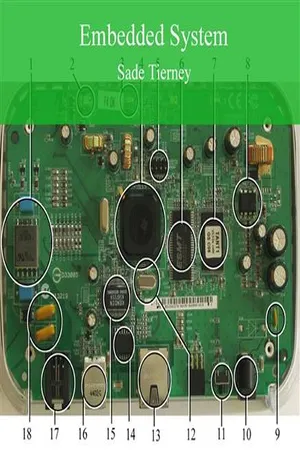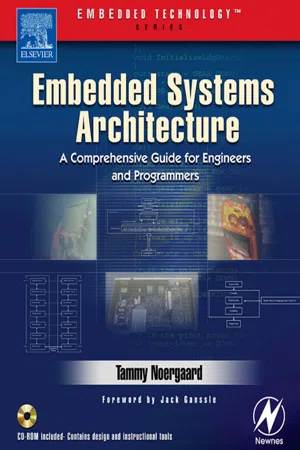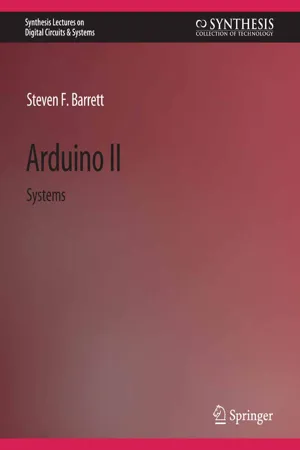Computer Science
Examples of Embedded Systems
Embedded systems are specialized computing systems designed to perform specific functions within a larger mechanical or electrical system. Examples of embedded systems include microcontrollers in household appliances, automotive control systems, industrial automation, and medical devices. These systems are typically optimized for low power consumption, real-time operation, and reliability.
Written by Perlego with AI-assistance
Related key terms
1 of 5
10 Key excerpts on "Examples of Embedded Systems"
- Ahmad Ibrahim(Author)
- 2003(Publication Date)
- Newnes(Publisher)
1 CHAPTER 1 Embedded Systems: An Overview 1.1 Definition and Examples A system whose principal function is not computational but is controlled by a computational system embedded within it is referred to as a computational embedded system, which is usually shortened to embedded system . The word embedded implies that the computational system lies within an overall system. The user of the overall system may not even be aware of the computational system’s existence. The phrase “computational system” refers to computers, micro-processors, microcontrollers, DSP chips, or custom-made hardware along with the software that may be associated with them. Desktop or laptop computers, although they contain microprocessors, are not considered embedded systems since their principal function is computational. If such a computer is customized and built permanently into an identifiable system with the sole purpose of controlling that particular system, then one can refer to it as part of an embedded system. Embedded systems are used in a wide range of applications. They can be loosely categorized as: ■ Consumer Electronics including digital cameras, televisions, cell phones, and camcorders. ■ Home Appliances including microwave ovens, rice cookers, thermostats, washing machines, and drying machines. ■ Business and Office Equipment including alarm systems, card readers, product scanners, cash registers, fax machines, and copiers. ■ Transportation Systems including automobiles (transmission control, fuel injection, antilock brakes, and cruise control), train systems, and avionic systems. ■ Factory Control including machine control, instrumentation, and robotics. ■ Medical Systems including life-support systems, testing systems, and diagnostic systems. The list of embedded system applications is growing continuously and is almost endless.- No longer available |Learn more
- (Author)
- 2014(Publication Date)
- Research World(Publisher)
____________________ WORLD TECHNOLOGIES ____________________ Chapter 10 Embedded System Picture of the internals of an ADSL modem/router. A modern example of an embedded system. Labelled parts include a microprocessor (4), RAM (6), and flash memory (7). ____________________ WORLD TECHNOLOGIES ____________________ An embedded system is a computer system designed to perform one or a few dedicated functions often with real-time computing constraints. It is embedded as part of a complete device often including hardware and mechanical parts. By contrast, a general-purpose computer, such as a personal computer (PC), is designed to be flexible and to meet a wide range of end-user needs. Embedded systems control many devices in common use today. Embedded systems are controlled by one or more main processing cores that are typically either microcontrollers or digital signal processors (DSP). The key characteristic, however, is being dedicated to handle a particular task, which may require very powerful processors. For example, air traffic control systems may usefully be viewed as embedded, even though they involve mainframe computers and dedicated regional and national networks between airports and radar sites (each radar probably includes one or more embedded systems of its own). Since the embedded system is dedicated to specific tasks, design engineers can optimize it to reduce the size and cost of the product and increase the reliability and performance. Some embedded systems are mass-produced, benefiting from economies of scale. Physically, embedded systems range from portable devices such as digital watches and MP3 players, to large stationary installations like traffic lights, factory controllers, or the systems controlling nuclear power plants. Complexity varies from low, with a single microcontroller chip, to very high with multiple units, peripherals and networks mounted inside a large chassis or enclosure. - No longer available |Learn more
- (Author)
- 2014(Publication Date)
- White Word Publications(Publisher)
____________________ WORLD TECHNOLOGIES ____________________ Chapter 8 Embedded System Picture of the internals of an ADSL modem/router. A modern example of an embedded system. Labelled parts include a microprocessor (4), RAM (6), and flash memory (7). An embedded system is a computer system designed to perform one or a few dedicated functions often with real-time computing constraints. It is embedded as part of a complete device often including hardware and mechanical parts. By contrast, a general-purpose computer, such as a personal computer (PC), is designed to be flexible and to meet a wide range of end-user needs. Embedded systems control many devices in common use today. ____________________ WORLD TECHNOLOGIES ____________________ Embedded systems are controlled by one or more main processing cores that are typically either microcontrollers or digital signal processors (DSP). The key characteristic, however, is being dedicated to handle a particular task, which may require very powerful processors. For example, air traffic control systems may usefully be viewed as embedded, even though they involve mainframe computers and dedicated regional and national networks between airports and radar sites (each radar probably includes one or more embedded systems of its own). Since the embedded system is dedicated to specific tasks, design engineers can optimize it to reduce the size and cost of the product and increase the reliability and performance. Some embedded systems are mass-produced, benefiting from economies of scale. Physically, embedded systems range from portable devices such as digital watches and MP3 players, to large stationary installations like traffic lights, factory controllers, or the systems controlling nuclear power plants. Complexity varies from low, with a single microcontroller chip, to very high with multiple units, peripherals and networks mounted inside a large chassis or enclosure. - No longer available |Learn more
- (Author)
- 2014(Publication Date)
- The English Press(Publisher)
________________________ WORLD TECHNOLOGIES ________________________ Chapter- 1 Introduction to Embedded System Picture of the internals of an ADSL modem/router. A modern example of an embedded system. Labelled parts include a microprocessor (4), RAM (6), and flash memory (7). An embedded system is a computer system designed to perform one or a few dedicated functions often with real-time computing constraints. It is embedded as part of a complete device often including hardware and mechanical parts. By contrast, a general-purpose computer, such as a personal computer (PC), is designed to be flexible and to meet a wide range of end-user needs. Embedded systems control many devices in common use today. Embedded systems are controlled by one or more main processing cores that are typically either microcontrollers or digital signal processors (DSP). The key characteristic, how- ________________________ WORLD TECHNOLOGIES ________________________ ever, is being dedicated to handle a particular task, which may require very powerful processors. For example, air traffic control systems may usefully be viewed as embedded, even though they involve mainframe computers and dedicated regional and national net-works between airports and radar sites (each radar probably includes one or more embedded systems of its own). Since the embedded system is dedicated to specific tasks, design engineers can optimize it to reduce the size and cost of the product and increase the reliability and performance. Some embedded systems are mass-produced, benefiting from economies of scale. Physically, embedded systems range from portable devices such as digital watches and MP3 players, to large stationary installations like traffic lights, factory controllers, or the systems controlling nuclear power plants. Complexity varies from low, with a single microcontroller chip, to very high with multiple units, peripherals and networks mounted inside a large chassis or enclosure. - eBook - PDF
Embedded Systems Architecture
A Comprehensive Guide for Engineers and Programmers
- Tammy Noergaard(Author)
- 2005(Publication Date)
- Newnes(Publisher)
However, you will find that the definition of “embedded system” is fluid and difficult to pin down, as it constantly evolves with advances in technology and dramatic decreases in the cost of implementing vari-ous hardware and software components. In recent years, the field has outgrown many of its traditional descriptions. Because the reader will likely encounter some of these descriptions and definitions, it is important to understand the reasoning behind them and why they may or may not be accurate today, and to be able to discuss them knowledgeably. Following are a few of the more common descriptions of an embedded system: Embedded systems are more limited in hardware and/or software functionality than a personal computer (PC). This holds true for a significant subset of the embed-ded systems family of computer systems. In terms of hardware limitations, this can mean limitations in processing performance, power consumption, memory, hardware functionality, and so forth. In software, this typically means limitations relative to a PC—fewer applications, scaled-down applications, no operating system (OS) or a limited OS, or less abstraction-level code. However, this definition is only partially true today as boards and software typically found in PCs of past and present have been repackaged into more complex embedded system designs. An embedded system is designed to perform a dedicated function. Most embedded devices are primarily designed for one specific function. However, we now see devices such as personal data assistant (PDA)/cell phone hybrids, which are embed-ded systems designed to be able to do a variety of primary functions. Also, the latest digital TVs include interactive applications that perform a wide variety of general In This Chapter Define embedded system Introduce the design process Define an embedded systems architecture Discuss the impact of architecture Summarize the remaining sections of the book - eBook - PDF
Computers as Components
Principles of Embedded Computing System Design
- Marilyn Wolf(Author)
- 2008(Publication Date)
- Morgan Kaufmann(Publisher)
But a fax machine or a clock built from a microprocessor is an embedded computing system. 1 2 CHAPTER 1 Embedded Computing This means that embedded computing system design is a useful skill for many types of product design. Automobiles, cell phones, and even household appliances make extensive use of microprocessors. Designers in many fields must be able to identify where microprocessors can be used, design a hardware platform with I/O devices that can support the required tasks, and implement software that performs the required processing. Computer engineering, like mechanical design or thermo-dynamics,is a fundamental discipline that can be applied in many different domains. But of course, embedded computing system design does not stand alone. Many of the challenges encountered in the design of an embedded computing system are not computer engineering—for example, they may be mechanical or analog electri-cal problems. In this book we are primarily interested in the embedded computer itself, so we will concentrate on the hardware and software that enable the desired functions in the final product. 1.1.1 Embedding Computers Computers have been embedded into applications since the earliest days of com-puting. One example is the Whirlwind, a computer designed at MIT in the late 1940s and early 1950s. Whirlwind was also the first computer designed to support real-time operation and was originally conceived as a mechanism for controlling an aircraft simulator. Even though it was extremely large physically compared to today’s computers (e.g., it contained over 4,000 vacuum tubes), its complete design from components to system was attuned to the needs of real-time embedded com-puting. The utility of computers in replacing mechanical or human controllers was evident from the very beginning of the computer era—for example,computers were proposed to control chemical processes in the late 1940s [Sto95]. - eBook - PDF
High-Performance Embedded Computing
Architectures, Applications, and Methodologies
- Wayne Wolf(Author)
- 2010(Publication Date)
- Morgan Kaufmann(Publisher)
We can see that computers were embedded early in the history of computing: * Many of the dates in this figure were found in Wikipedia; others are from http://www.motofuture.motor-ola.com and http://www.mvista.com . history of embedded computing 4 Chapter 1 Embedded Computing one of the earliest computers, the MIT Whirlwind, was designed for artillery control. As computer science and engineering solidified into a field, early research established basic techniques for real-time computing. Some techniques used today in embedded computing were developed specifically for the prob-lems of embedded systems while others, such as those in the following list, were adapted from general-purpose computing techniques. ■ Low-power design began as primarily hardware-oriented but now encom-passes both software and hardware techniques. ■ Programming languages and compilers have provided tools, such as Java and highly optimized code generators, for embedded system designers. ■ Operating systems provide not only schedulers but also file systems and other facilities that are now commonplace in high-performance embedded systems. Figure 1-2 Highlights in the history of embedded computing. 1.2 Example Applications 5 ■ Networks are used to create distributed real-time control systems for vehi-cles and many other applications, as well as to create Internet-enabled appliances. ■ Security and reliability are an increasingly important aspect of embedded system design. VLSI components are becoming less reliable at extremely fine geometries while reliability requirements become more stringent. Security threats once restricted to general-purpose systems now loom over embedded systems as well. Some knowledge of the applications that will run on an embedded system is of great help to system designers. This section looks at several basic concepts in three common applications: communications/networking, multimedia, and vehicles. - eBook - ePub
- Wai-Kai Chen(Author)
- 2003(Publication Date)
- CRC Press(Publisher)
Finally, microprocessors aid in concurrent engineering. After some initial design decisions have been made, hardware and software can be designed in parallel, reducing total design time. While embedded computing systems traditionally have been fabricated at the board level out of multiple chips, embedded computing systems will play an increasing role in integrated circuit design as well. As VLSI technology moves toward the ability to fabricate chips with billions of transistors, integrated circuits will increasingly incorporate one or several microprocessors executing embedded software. Using microprocessors as components in integrated circuits increases design productivity, since CPUs can be used as large components which implement a significant part of the system functionality. Single-chip embedded systems can provide much higher performance than board-level equivalents, since chip-tochip delays are eliminated. 5.3 Embedded System Architectures Although embedded computing spans a wide range of application areas, from automotive to medical, there are some common principles of design for embedded systems. The application-specific embedded software runs on a hardware platform. An example hardware platform is shown in Fig. 5.1. It contains a microprocessor, memory, and I/O devices. When designing on a general-purpose system such as a PC, the hardware platform would be predetermined, but in hardware/software co-design the software and hardware can be designed together to better meet cost and performance requirements. FIGURE 5.1 Hardware structure of a miroprocessor system. Depending on the application, various combinations of criteria may be important goals for the system design. Two typical criteria are speed and manufacturing cost. The speed at which computations are made often contributes to the general usability of the system, just as in general-purpose computing - Steven F. Barrett(Author)
- 2022(Publication Date)
- Springer(Publisher)
Throughout these chapters, we show how the built–in features of the Arduino Development Environment may be employed in different applications. In this chapter, we begin with a definition of just what is an embedded system.We then explore the process of how to successfully (and with low stress) develop an embedded system prototype that meets established requirements. We conclude the chapter with an extended example. The example illustrates the embedded system design process in the development and prototype of the autonomous maze navigating robot based on the Blinky 602A (www.graymarkint.com) controlled by the Arduino UNO R3 processing board. 3.1 WHAT IS AN EMBEDDED SYSTEM? An embedded system contains a microcontroller to accomplish its job of processing system inputs and generating system outputs. The link between system inputs and outputs is provided by a coded 70 3. EMBEDDED SYSTEMS DESIGN algorithm stored within the processor’s resident memory. What makes embedded systems design so interesting and challenging is the design must also take into account the proper electrical interface for the input and output devices, limited on–chip resources, human interface concepts, the operating environment of the system, cost analysis, related standards, and manufacturing aspects [Anderson]. Through careful application of this material you will be able to design and prototype embedded systems based on the Arduino microcontroller. 3.2 EMBEDDED SYSTEM DESIGN PROCESS In this section, we provide a step–by–step approach to develop the first prototype of an embedded system that will meet established requirements. There are many formal design processes that we could study. We concentrate on the steps that are common to most. We purposefully avoid formal terminology of a specific approach and instead concentrate on the activities that are accomplished as a system prototype is developed.- eBook - PDF
Arduino II
Systems
- Steven F. Barrett(Author)
- 2022(Publication Date)
- Springer(Publisher)
223 C H A P T E R 7 Embedded Systems Design Objectives: After reading this chapter, the reader should be able to do the following: • define an embedded system; • list all aspects related to the design of an embedded system; • provide a step-by-step approach to embedded system design; • discuss design tools and practices related to embedded systems design; and • apply embedded system design practices in the design of a microcontroller system em- ploying several interacting subsystems. 7.1 OVERVIEW In this chapter, 1 we begin with a definition of just what is an embedded system. We then explore the process of how to successfully (and with low stress) develop an embedded system prototype that meets established requirements. We conclude the chapter with several examples. 7.2 WHAT IS AN EMBEDDED SYSTEM? An embedded system contains a microcontroller to accomplish its job of processing system in- puts and generating system outputs. The link between system inputs and outputs is provided by a coded algorithm stored within the processor’s resident memory. What makes embedded sys- tems design so interesting and challenging is the design must also take into account the proper electrical interface for the input and output devices, limited on-chip resources, human interface concepts, the operating environment of the system, cost analysis, related standards, and manu- facturing aspects [Anderson [1]]. Through careful application of this material you will be able to design and prototype embedded systems based on the ATmega328 microcontroller. 7.3 EMBEDDED SYSTEM DESIGN PROCESS In this section, we provide a step-by-step approach to develop the first prototype of an embedded system that will meet established requirements. There are many formal design processes that we 1 The information on embedded system design first appeared in Microcontroller Fundamentals for Engineers and Scientists, Morgan & Claypool Publishers, 2006.
Index pages curate the most relevant extracts from our library of academic textbooks. They’ve been created using an in-house natural language model (NLM), each adding context and meaning to key research topics.









